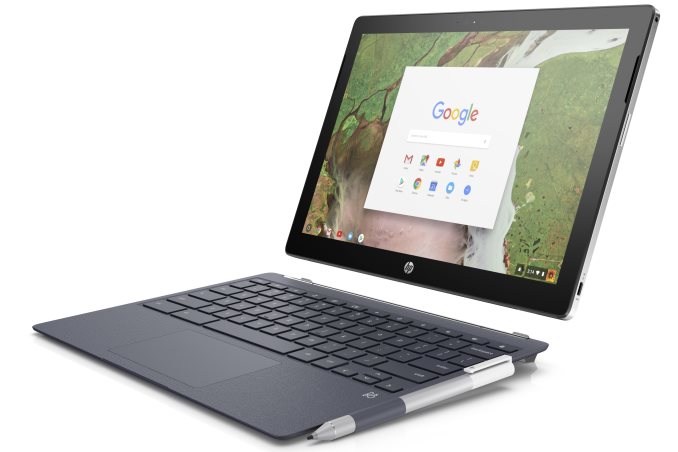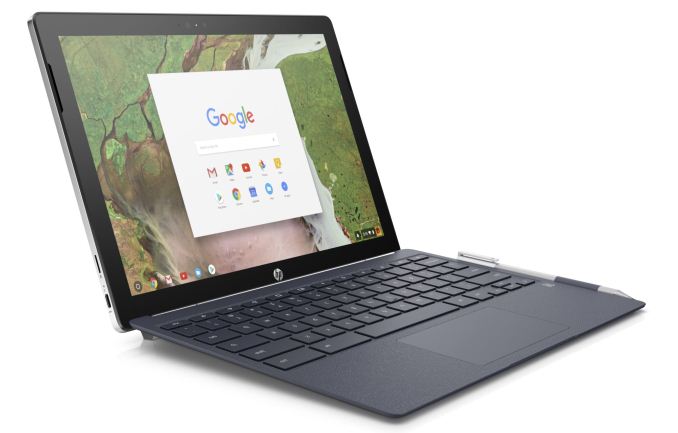HP Unveils Chromebook x2: A 12.3-inch 2400x1600 2-in-1 with Intel Core-Y
by Joe Shields on April 9, 2018 8:00 AM EST- Posted in
- Laptops
- Intel
- HP
- Chromebook
- detachable
- 7th Gen
- Chromebook x2

Chromebooks are still seen is one of the faster-growing segments of the PC category, and today HP is unveiling a detachable device with its new Chromebook x2. The Chromebook x2 claims to combine the functionality of Chrome OS into a more versatile form factor. The Chromebook x2 will feature a 7th Generation Intel Core-Y series processor, up to 8 GB of RAM, 32 GB of internal storage, and a 12.3-inch IPS WLED-backlit touchscreen. These specifications, along with access to the Google Play store, are aiming to provide users with a high-performing device for productivity and entertainment purposes in a flexible form factor.
The exterior of the has a premium look to it with a ceramic white anodized aluminum finish and an almost leather-like Oxford Blue surface on the keyboard. The Quad HD (2400x1600) 12.3-inch IPS screen is said to have increased durability and scratch resistance with its Corning Gorilla Glass 4 touch display. Switching from a productivity mode to a creative mode should be seamless with its magnetic hinge. The hinge provides the strength and rigidity necessary to keep it attached and upright while in laptop mode, yet should make it easy to detach when transitioning to a tablet. The tablet section measures in at 8.2mm and 1.62 lbs (or 15.3mm and 4.14 lbs with the keyboard).
Hardware wise, the Chromebook x2 uses an Intel Core M3-7Y30 processor (two cores with hyperthreading). The base configuration includes 4 GB LPDDR3-1600 and supports up to 8 GB total (although memory is not user accessible). Internal storage comes with 32 GB eMMC memory, expandable to 256 GB through a microSD card slot. Putting an image on the screen is the Intel HD Graphics 615 solution integrated into the CPU which is enough for Google Play games and entertainment purposes. With all this hardware, battery life is expected to last around 10 hours.
For networking and connectivity, the Chromebook x2 gets out to the internet using an 802.11ac 2x2 Wi-Fi and supports Bluetooth 4.2 – no wired network options are available without a USB dongle. There is a multi-format digital card reader, two USB 3.0 Type-C ports, and a headphone/microphone combo jack for audio. When not using headphones, the Chromebook x2 has two integrated stereo HP speakers custom tuned by B&O Play. It also includes the HP Active Pen for sketch, blend, and write capabilities. The detachable island-style keyboard with an integrated numeric pad is backlit to help users working in darker environments.
| HP Chromebook x2 | |||
| Type | Detachable Chromebook | ||
| Processors | Intel Core M3-7Y30 (2C/4T, 2.6 GHz Max. Turbo) | ||
| Maximum Memory | 8 GB LPDDR3-1600 SDRAM | ||
| Network Connectivity | 802.11ac Dual Band 2x2, Bluetooth 4.2 | ||
| Internal Storage | 32 GB eMMC (expandable to 256 GB via Micro SD expansion) | ||
| Graphics | Intel HD Graphics 615 | ||
| Expansion Slots | Micro SD Card reader | ||
| Display | 12.3" 2K (2400x1600) IPS WLED-backlit touchscreen panel | ||
| Ports and Connectors | 2 x USB 3.0 Type-C 1 x Headphone/Microphone Combo Jack |
||
| Input Device | Full-size island-style backlit keyboard w/number pad | ||
| Camera | HP Wide Vision 5MP front facing HP 13MP rear facing |
||
| Power | 48Wh 4-Cell Lithium-Ion battery 45W Slim AC Adapter |
||
| Dimensions (W x D x H) |
11.50" x 8.32" x 0.33" | ||
| Weight | 1.62 lbs (tablet), 3.07 lbs (tablet + base) | ||
| Price (Starting) | $599 | ||
Overall the HP Chromebook x2 looks like an interesting product offering users a new 2-in-1 option in the Chromebook ecosystem. It will be available through HP.com and Best Buy on June 10th starting off at $599. Additional announcements from HP's Spring Range will be released in the coming days.
Related Reading
- HP Spring 2018 Range: ZBook, ZBook, ZBook
- Dell's Spring Range: New 8th Gen Alienware, Laptops, and Monitors
- Acer Announces New Chromebooks and Chromebox Devices
- HP Announces the Latest Chromebook 14 G5 and Chromebook 1 G6: Up to 7th Gen Quad Core Celeron
- HP Announces ZBook x2: HP's First Detachable Workstation
Source: Hp














41 Comments
View All Comments
SirPerro - Monday, April 9, 2018 - link
I like the direction this Chromebook/Android tablet merger is taking.ToTTenTranz - Monday, April 9, 2018 - link
32GB eMMC seems both anemic and slow for a $600 device...If it's using a Core Y then it would already have hardware support for NVMe storage.
Does ChromeOS support android apps installed through the play store?
jabber - Monday, April 9, 2018 - link
You haven't really followed the whole Chromebook scene have you?ToTTenTranz - Monday, April 9, 2018 - link
Nope.Which is why I'm asking...
willis936 - Monday, April 9, 2018 - link
I don’t know it much either but I think internally they’re closer to android tablet than windows laptop. However I think something like UFS might be a better choice when reacing for the high end of this segment. eMMC was by far the most painful part of smartphones when it was the only choice 8 years ago. It should be buried for any human interface tech and kept to the space it was designed for: embedded.CajunMoses - Monday, April 9, 2018 - link
Yes, Chrome OS comes with Android Play Store enabled. The integration is very good at this point and continually getting better. But many Play Store apps haven't yet been rewritten to enable doing everything with a mouse that they will do with touch -- like for instance dragging to select text.Retycint - Monday, April 9, 2018 - link
Chrome OS is all about cloud storage (or at least that's how Google wants you to use it); the physical storage is there simply for the OS itself and any temporary storage of files. In fact most chromebooks bar the $1k+ ones have eMMC storage.And yes it supports some android apps if I recall correctly
Samus - Tuesday, April 10, 2018 - link
Assuming the micro SD slot is PCIe based (it is on the 3 year old Baytrail platform, so I'm sure it is here) putting a cheap U3 SDHC card in will offer 150MB/sec of storage perfromance.Put into perspective, I can't think of a single Chrome OS app that's larger than 150MB.
As far as storage of non-apps go, such as pictures and documents, most people keep that on Google Drive. Chrome OS devices are mostly useless without an internet connection so tethering them to cloud storage isn't really a downer. But I keep movies and torrent downloads on my SDHC card in my Chromebook (and my Windows 10 tablet) where performance is mostly moot. As long as it can stream a 3000mbit video file, it's fine. Decompressing RAR's from SDHC to SDHC is a little painful because of the single-channel architecture of the eMMC controllers, but it's generally a few minutes for a set of RAR's totaling 2GB.
StevoLincolnite - Monday, April 9, 2018 - link
Why DDR3?Can you install windows on this thing? Hard to find a low-priced Windows notebook with a display like that?
zepi - Monday, April 9, 2018 - link
LPDDR3 is highest supported by Intel chips. None of their core-series processors support LPDDR4.